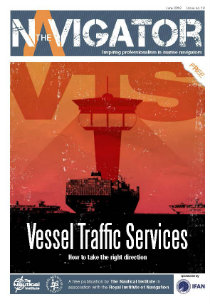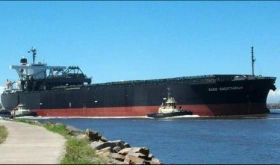This post is an extract from EMSA’s publication “Addressing Illegal Discharges in the Marine Environment” focusing on the various ways oily waste are being produced onboard vessels. The volume of oily waste generated and/or stored on board a vessel depends on various factors. These include, for example type, age and size of vessel; type and age of equipment related to oil separation and storage; maintenance of vessel and equipment and external factors such as availability of Port Reception Facilities.
Three categories of oily waste generally accumulate on board large vessels. These are oily bilge water, oil residue and oil cargo residues on tankers.
The components of bilge water and quantities produced vary considerably from vessel to vessel, but the waste generated is usually a thinner and lighter than sludge waste. It is also comprised of more varied elements. Quantities of sludge waste by comparison, are more consistent in composition and quantity, at about 1-2% of the volume of fuel oil consumed on board. Sludge is much thicker and heavier than bilge water, and more persistent. The properties of oil cargo residues will depend on the type of cargo carried.
Oily bilge water
Defined in MARPOL annex I as water which may be contaminated by oil resulting from things such as leakage or maintenance work in machinery spaces. Any liquid entering the bilge system including bilge wells, bilge piping, tank top or bilge holding tanks is considered oily bilge water. In addition to oil, bilge water often contains quantities of detergents and solvents.
Machinery spaces on large commercial vessels contain a wide array of engineering systems, including those used to manage fuel, lubrication, fuel and lubricating oil purification, saltwater service, bilge and ballast, firefighting and sewage. Each system contains numerous pumps, fittings, control devices and other components, along with extensive lengths of piping. All components are engineered to prevent and minimize leakages through the use of mechanical seals, gaskets, etc. Despite this, because machinery spaces are so huge, waste accumulation of 20 cubic metres per day or more may occur. Bilge collects in bilge wells, and from there is pumped to bilge water holding tanks, where fitted.
Oil residue (sludge)
Defined in MARPOL annex I as the residual waste oil products generated during the normal operation of a ship such as those resulting from the purification of fuel or lubricating oil for main or auxiliary machinery, separated waste oil from oil filtering equipment, waste oil collected in drip trays, and waste hydraulic and lubricating oils.
Deep-draught vessels generally burn low quality heavy fuel oil in their engines. This fuel contains contaminates. To prevent damage to engine components, retard wear, and improve combustion, the fuel is purified by centrifuges before entering the engines (a fuel oil purifier room is shown on the photo at the beginning of this article). At preset intervals, a shoot cycle occurs, which ejects contaminates (sludge), which drain to a sludge tank.
Compared with bilge water, fuel oil sludge is generally less varied and the quantities are more predictable, provided the quality of the fuel oil remains constant. Sludge waste is much heavier than bilge water. As a general rule of thumb, approximately 1-2% of the heavy fuel oil burned in a vessel’s main engine and generators ends up as sludge. The quantity could vary depending on the fuel’s quality, its compatibility with previous shipboard fuels and the condition of the equipment used to store, transfer and heat it.
Main and auxiliary engine lubricating oil is similarly processed. The equipment may be self-cleaning, and the resultant sludge and waste fluids enter a sludge tank. The waste quantities produced in this process are normally less than the quantities resulting from fuel oil. Depending on the engine type, the area between the pistons and cylinders may also be lubricated by a separate system. The waste gravitates to a separate sludge oil tank known as a stuffing box or lantern ring drain tank.
Oil cargo (refined product or crude oil)
Product (refined oil) cargo residue waste
Tanker vessels have numerous tanks and may carry many different cargoes at the same time, varying from different types of petroleum products to chemicals and food products. As a result, these cargo tanks must usually be cleaned between carrying different cargoes. Tanks carrying refined petroleum products can be cleaned by pumping water through the cargo tank washing system, by steam cleaning or spraying pressurized hot water.
A quantity of sea water, up to several hundred tonnes, will be taken on board into a slop tank. This water is recycled from the slop tank through the cargo tank washing system. On completion of tank washing, and stripping of the washed tanks and pipelines, the slop tank will contain the saltwater used for washing, the cargo residues, and unpumpable quantities from each tank. These quantities will be measured, the interface recorded and cubic metres calculated. A chemical/products tankers slop tank, during repairs, is shown on the photo below.
The vessel may choose to discharge a quantity of the slops (water) through its Oil Discharge Monitoring and Control system into the sea after the slops/cargo residues have settled out and the interface-measured quantities have been calculated, in accordance with MARPOL requirements.
Crude oil cargo residue waste
On completion of crude oil discharge operation from a tanker, there will be unpumpable quantities of cargo residue in each tank. Unpumpable quantities in crude tankers will vary more than for product tankers, due to the size of the cargo tanks and nature of the cargo.
In the past, the process was essentially the same as for refined product cargo, but in recent years specific crude oil washing (COW) processes have been introduced, which use the crude oil cargo of the oil tanker to clean the residue from the tanks. The crude oil is heated then sprayed using high pressure nozzles onto the walls of the cargo tank. This reduces considerably the amount remaining on board, resulting in savings due to the increased quantity discharged, whilst also reducing the eventual volume of waste. MARPOL made COW systems mandatory for oil tankers of 20,000 tonnes or more.
Oily waste tanks
The names and arrangement of oily waste tanks on vessels will differ according to the type and size of vessel. All vessels over 400 gt are required to have tanks for collecting oily residues (sludge) and they should be of a size that is adequate to the operation of the vessel. Bilge water holding tanks are not mandatory but are fitted to most vessels. Vessels over 400 gt are also required to be fitted with oil filtering equipment that may include any combination of a separator, filter or coalescer, and also a single unit designed to produce an effluent with oil content not exceeding 15 ppm. A possible example of oily waste production and tank arrangements is shown on the figure below.
The International Oil Pollution Prevention (IOPP) certificate and appendix will contain information about the tanks and equipment on board that particular vessel for the handling of oily waste. The vessel will also have piping and tank diagrams for the various systems. The IOPP certificate, piping diagrams and Oil Record Book should contain a tank plan. The ship’s Oil Record Book contains instructions on the information which must be recorded relating to oil transfers as well as the mandatory log of oil, sludge and bilge water transfers.
Source: EMSA

















Leave a Comment